Estimates of War Orphans of WWII
Approximately 13,000,000 European children became war orphans at the end of WWII.* This is the story of one Italian orphan whom my grandmother supported financially for a time after the end of the war.
Grammy and the Methodist Church
When my grandmother, Wava Farrington, was still alive, I sometimes teasingly referred to her as Mrs. John Wesley because of her devotion and commitment to the Methodist Church. She was active in the church long before I was born and she expected that my brothers, my cousins and I would all demonstrate the same level of commitment. To that end she drove us to Sunday school and church every Sunday morning of my life until my family moved from Lincoln, Kansas. The only acceptable excuse for being absent – in Grammy’s opinion – would have been death, and even then Grammy would probably have expected us to rise from the dead to confirm her faith and make certain we didn’t shirk our Christian responsibilities.
Shortly after the first of the year, 1956, my grandmother heard a presentation about Casa Materna Orphanage in Portici, Naples, Italy. It was “the only Methodist orphanage and the only Protestant one in all Italy.” (The Norwalk Hour, Norwalk, Connecticut. April 4, 1967.) More than half the orphanage’s financial support came from Methodists in the U. S. with part of that support coming in the form of donations when the Casa Materna Children’s Choir made it’s annual tour to the United States. Grammy learned of the orphanage and the choir just prior to its departure from Italy for it’s 1956 United States concert tour.
Grammy wrote to the orphanage saying that she wanted to sponsor a girl with a special need. Although I don’t have a copy of her letter, based on the response she received from the assistant director, Dr. Teofilo Santi, I think Grammy expressed a desire to sponsor one of the girls in the choir, hoping that she and the girl could meet when the choir toured the U. S.
Dr. Santi wrote back with a name – Nunzia D’ Ariano, a 17 year old girl who had lived at Casa Materna since 1950. Below is Nunzia’s story, taken from Dr. Santi’s letter dated March, 1956.
Nunzia’s story
Nunzia “spent her childhood in the most squalid misery in the caves of Naples. Her father is a cripple and her mother had tuberculosis and died several years ago. After her death the father tried to earn a living but was unable to do so. Some of the neighbors took pity on the child and tried to help her, then brought her to Casa Materna where she has been for five years. It took her a long time to learn to smile but she has finally found out that life can hold pleasant things as well as sad ones and she has become a sweet, happy, and helpful girl. Her school work has always been difficult for her and she could hardly keep up with the other children. On the other hand, the choir [of Casa Materna] has meant a great deal to her, for she loves to sing, and in really accomplishing something she has found herself as a human being. I am sure you will love Nunzia when you meet her. Certainly, she has a special need of a friend. Enclosed you will find a photograph of Nunzia.”
In the small stack of photos that Grammy kept and treasured is a photo of Nunzia taken just prior to the choir’s departure from Italy. You can see the remarkable transformation in Nunzia as a result of living at the orphanage, having regular medical care, meals, clothing, and shelter – all the things we take for granted if we aren’t living in a war zone.
The Casa Materna choir appeared for its first U. S. performance of 1956 on February 20. Orfeo Pinna, choir master, had worked up two different programs, A and B for the choir so that the performers didn’t have to sing the same songs each night. The schedule was grueling – Program A at Scarsdale, New York on the 20th, Program B at Mt. Vernon, N. Y., on the 21st, Program A at Manaroneck, N. Y., on the 22nd, Program B at Crestwood, N. Y., on the 23rd and on and on and on.
In the meantime, Grammy was exchanging phone calls with the tour director for the choir, trying to arrange a way that she could meet Nunzia, and perhaps even bring her to Lincoln, Kansas for a day or two. I vaguely remember the tension at Grammy’s house as she talked with my mom (we lived across the alley from Grammy) about the progress and set-backs in trying to make those arrangements. The biggest problem was working out the logistics so Nunzia could leave the choir for an over-night visit without missing any performances.
At last arrangements were finalized. Grammy and Grampy drove to Salina, Kansas, 40 miles from Lincoln, and heard the choir perform. I don’t know how it happened, but the local newspaper learned of the meeting between a local woman and a choir member, and published a picture and story about Grammy and Nunzia in the local paper. The photo is the one you see at the beginning of this blog and the story is reproduced below.
After the performance my grandparents drove Nunzia to Lincoln for the night. It was very late by the time they arrived back home, but I remember clearly Grammy and Nunzia walking through the back door of my folks’ house. My dad, who was a traveling salesman, was on the road and gone for the night. My two younger brothers were already in bed, sound asleep. My mom and I were still up, waiting. Nunzia gave me a shy smile – she didn’t speak English and I, at age 6 didn’t speak Italian. I smiled and waved and nodded my head. My mom, smiling the entire time, gave Nunzia a huge hug which Nunzia returned. Grammy smiled, talked and gestured throughout our brief meeting, then she and Nunzia walked back across the alley to Grammy’s house for a late-night visit and a good night’s sleep.
Everyone had to get up early the next morning – for more picture taking, breakfast, and then to take Nunzia back to Salina so she could re-join the choir before they headed out to their next stop, Winfield, Kansas.
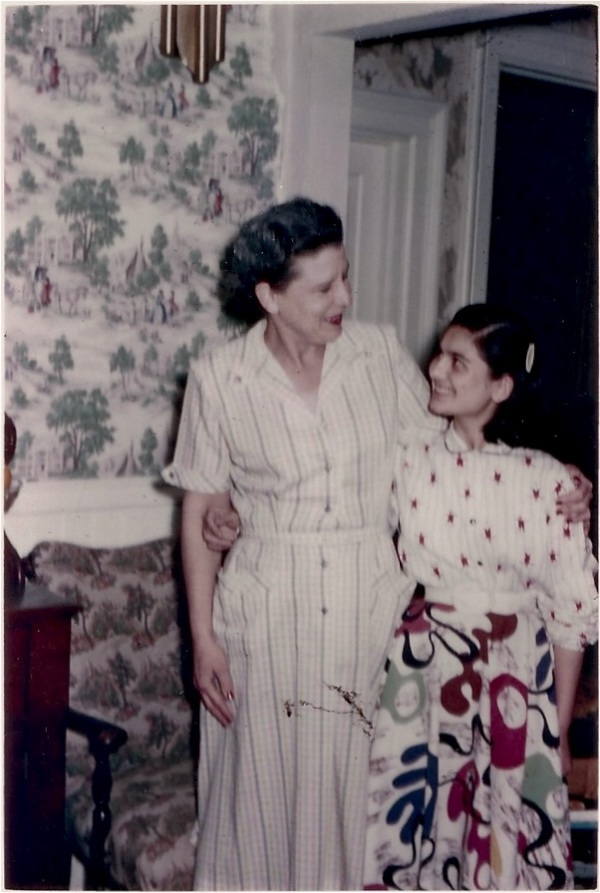
Grammy and Nunzia in Grammy’s dining room. (Sorry about the blemish on Grammy’s dress. There’s a blemish on the photo.)
Nunzia and the choir completed their American tour in June of 1956 and then returned to Italy. Nunzia remained at Casa Materna until close to the end of the year when the orphanage received a letter from Nunzia’s father asking that she be released to come home and assist him. By this time Nunzia was 18. She had received training as a seamstress, and last anyone heard she set up shop and worked to support herself and her father.
The end of Casa Materna
Casa Materna continued on for some years but closed sometime in the 2000s. If you google “Casa Materna Orphanage Italy” you’ll find numerous web sites with information including a fascinating story about the orphanage and some of the crew of the USS Forrestal-CVA 59 at www.wellsclan.us/history/navyyrs/ss06.htm.
Other Resources for Further Research
The Lost Children, by Taza Zahra, published by Harvard University Press, 2011.
www.portraitsofwar.wordpress.com – This web site, created and maintained by Brennan Gauthier, an archaeologist for the State of Vermont, has memorable photos of war, including orphans of WWII. An excellent web site!
Notes:
*The Lost Children, page 6.

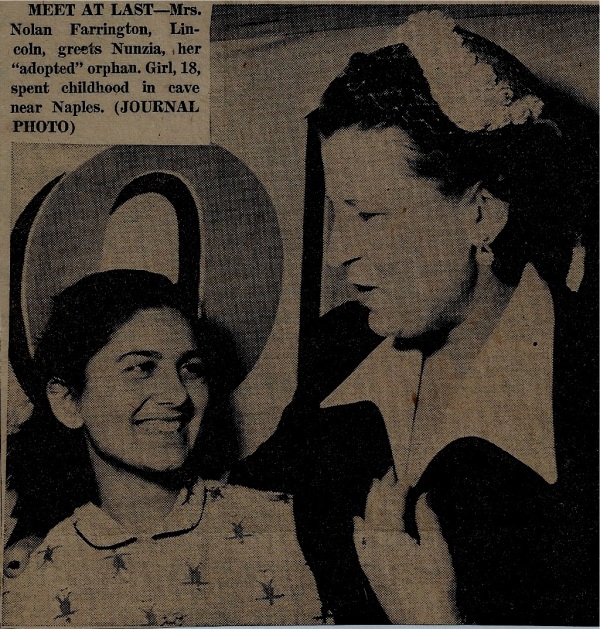
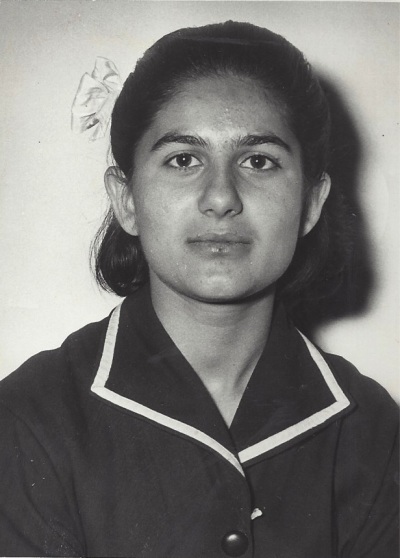
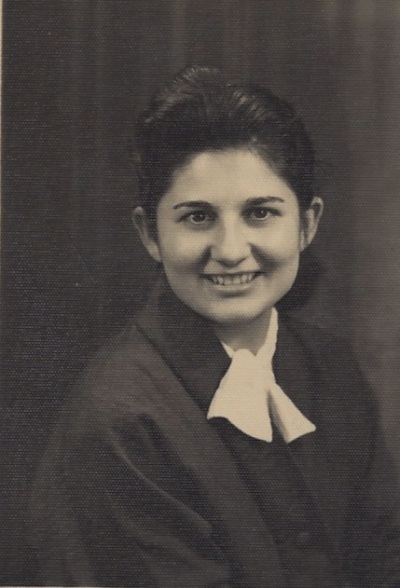
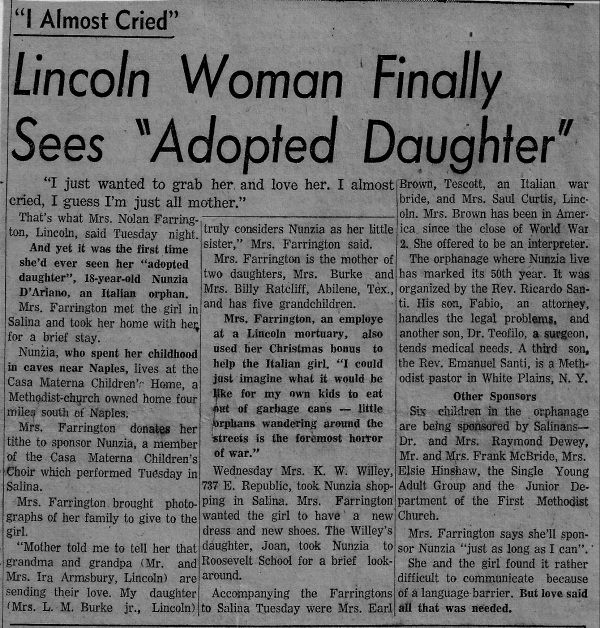

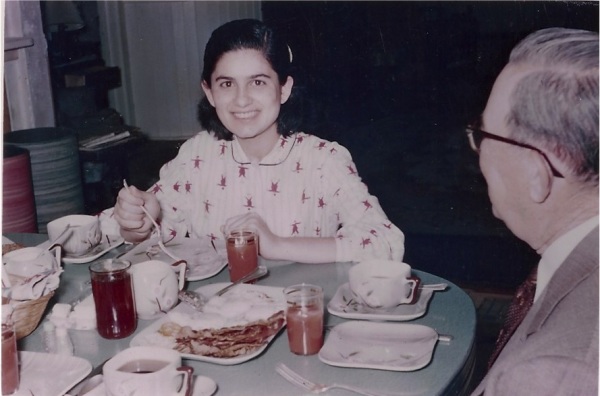
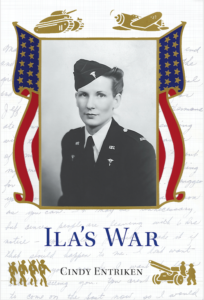
What a fascinating story!
What a wonderful story about Auntie Wava! I slept in the same bed! Have you tried to locate Nunzia or her family ?
Thanks, Cindy. I’m glad you enjoyed this story about Grammy. The photo of her and Nunzia in the paper is one of my favorites. I have not tried to locate Nunzia. It appears that Grammy and Nunzia exchanged letters through 1958 but I didn’t find anything beyond that. Honestly I don’t know how I would go about trying to find her. Do you have any suggestions?
Thanks, Jenny. With your interest and experience working with children I certainly see why this story was so fascinating for you. Hope I can come up with some more that you’ll like. Cindy
I loved the story and, of course, the wonderful photos. I know Nunzia has been forever grateful to Aunt Wava for her love and advocacy, and Nunzia brought immeasurable things to Aunt Wava’s life.
Thank you, Jan, for your lovely comments. I agree with you. Nunzia brought great joy to Grammy.
Good story. Reminds me of a foreign exchange student from Poland named Frank that stayed at my grandmas house in Hutchinson, Ks. I was young but no one in the family had ever met someone from outside the US at that time.
Don, thanks for sharing that tidbit of information.
Loved reading about your Grammy and Nunzia. What a heartwarming story!
Thank you for your kind words. I appreciate them a lot.
Great story, Cindy.
Hello! In the summer of 1949 while on a student study trip to Italy from Hamline University, St. Paul, MN, I had the privilege of visiting Casa Materna in Portici. We met the Santi brothers, Teofilo and Fabio, toured the school, visited the caves in Naples from which many of the orphans of Casa Materna had come and visited the school. Upon return to Minnesota it was a privilege to share the story of Casa Materna with various student and community groups. The study groups continue to travel around the world….SPAN, Student Project for Amity among Nations..
Mona, thanks for telling me about your experience with Casa Materna. I read about SPAN and am extremely impressed. I wish all students had such opportunities for meeting and learning about other cultures and people. I believe our only hope for avoiding war and destruction lies in learning that we are more alike than we are different.
Pure chance, brought this story about the Casa Materna to my attention. It was part of my childhood in Wichita where my father, Dr. S. Mancil Bell, was pastor of Grace Methodist Church in the early 1950s. As a chaplain in the US Army he visited Naples and the orphanage sometime in 1946-47 ( I don’t have the exact date). Returning from the war he carried the horrors and devastations (among the first into German death camps, the memories oppressing his kind spirit to the end of his days). He had Grace Church among those hosting the choir. I was perhaps 6 years old but we had two teenagers stay with us in the parsonage. I remember they both had injuries or handicaps. I also recall vividly going with my father when the choir sang on the first TV station in Wichita. And too their very mezzogiorno despair when they saw that my father had no Verdi records, they insisted we go to Wichita’s best record store and come back with Rigletto, La Traviata and Il Travatore–I still have these, they still play well. So you see the story of Casa Materna still plays on here too where I live in France. And in my head most certainly when I visit Naples. Thank you for bringing this back.
Jonathan, thank you so much for writing. It’s amazing how many times our paths have crossed over the years and yet we have never met. I live in Wichita and have since 1981, I used to live on South Topeka close to the church, and I’ve been to France several times, most recently 2014 for the 70th anniversary of D-Day. You may want to look at that blog to learn more about my trip to Normandy.
After I received your comments I re-read the blog entry and looked at the photos again experiencing the bittersweet memories of seeing my grandparents, and being in their home. I guess we never get over missing the folks we loved the most. But we are certainly fortunate to have wonderful memories. I wish you the best and hope those wonderful old records play well for another 65 years.
I, at last, came across your kind reply to my story about Casa Materna and my father, Rev S. Mancil Bell. Thank you. As you may know the Grace Church parsonage was on So. Topeka, where I lived too as a little boy. My mother was thus there twice as her father W.F. Little also pastored at Grace, in the 1920s. This repeated when again my father and grandfather pastored many years apart at the same Wichita church, Woodland. I have often been in Lincoln. For a few years my college girl friend’s mother came from there–family name Sherman. Doesn’t Lincoln qualify as a ‘Post Rock’ town? Kansas’ Post Rock Country has always interested me.
Hi, Jonathan. Yes, Lincoln is in Post Rock country. Many of the buildings on Lincoln’s main street were constructed using limestone – Post Rock – from the area.
I’m currently in the process of publishing my first book, Ila’s War, about my great aunt, Ila Armsbury, who was an Army nurse stationed in Australia during WWII. Much of the story of her early years occurred in and around Lincoln. If you’ve been up there, you’ll probably recognize some of the locations. My hope is to have the book available to the public by Memorial Day, 2020. Thanks for writing. Think about coming back to Kansas so we can meet over coffee or tea and talk about old times.
I have a 33 rpm record of the Casa Materna Choir, Orfeo Pinna and Fabio Santi, presented by The Casa Materna Aid Society in White Plains NY.
I gather it was prepared for the 1956 concert tour in the States. I was 13 at the time. Don’t know if the tour included Philadelphia near where we used to live. I only remember that I was struck by the harmony of their voices. Does anyone know anything more about that recording or tour?
Thanks. Simonetta
Hi, Simonetta. Thanks so much for reading my blog and asking about the tour. I’m sorry to tell you that I have no other information and wasn’t able to find anything else. I didn’t know there was a recording – if my grandmother had one it must have gone to one of the other grandchildren when she died in 2004. Because I was only 6 when Nuncia came to the States, I didn’t get an opportunity to hear the choir so I’m very happy to know that it sounded good. Best regards.
My mother was an elementary teacher at Casa Materna from 1950 to 1958. I remember visiting Casa Materna and meeting the two Santi brothers. It was a wonderful school with a stress on the academics. Located on beautiful grounds with pristine lawns and a very easy access to the nearby beach, it was a pleasure to visit. After my own classes in a Naples’s school, I delighted to spend my afternoons on Casa Materna beautiful grounds. The years were 1947 to 1954 that my mother was an elementary teacher at Casa Materna’s orphanage. Those were unforgettable times!
Max, thank you so much for sharing your memories with me. Casa Materna must have been a beautiful place offering such peace and healing for children of war. Sadly, we are seeing war today in the Ukraine which will likely result in a new group of war orphans. I can’t help but wonder who will be there to help? I hope you’ll keep on reading my blog. My best wishes to you.